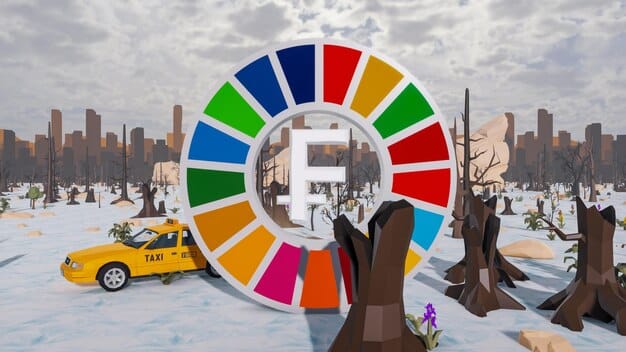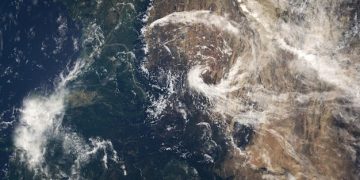Climate Change Denial: Misinformation and US Public Opinion

Climate change denial is significantly influenced by misinformation, which shapes public opinion in the United States, leading to debates over the severity and causes of climate change and hindering widespread acceptance of scientific consensus.
The spread of climate change denial in the U.S. is a complex issue, largely fueled by misinformation campaigns. Understanding the impact of these campaigns on public opinion is crucial for effective climate action.
Understanding climate change denial in the US
Climate change is one of the most pressing issues facing humanity. However, despite overwhelming scientific evidence, climate change denial persists, particularly in the United States. This denial is often fueled by misinformation, which undermines public understanding and support for climate action.
The roots of climate change denial are varied and complex, often intertwined with political ideologies, economic interests, and media coverage. Examining these factors provides valuable insights into how misinformation takes hold and shapes public discourse.
The Role of Political Ideology
Political affiliation significantly influences beliefs about climate change. Studies show a stark partisan divide, with conservatives being more likely to deny or downplay the severity of climate change compared to liberals.
- Political polarization exacerbates climate change disputes.
- Denial aligns with certain economic and regulatory preferences.
- Trust in scientists varies across the political spectrum.
This political divide isn’t new, but it has deepened over the past few decades. As climate change became more politicized, denial became a badge of identity for some political groups.

In summary, political ideology plays a crucial role in whether individuals accept or deny climate change, often overriding scientific consensus.
Sources and spread of climate change misinformation
Misinformation does not arise in a vacuum, it is seeded, grown, and harvested. Understanding the sources and distribution channels of this misinformation is crucial to addressing the problem.
Identifying the actors and channels involved is the first step in combating the spread of climate change denial. From organized groups to media outlets, diverse sources contribute to public confusion.
Organized climate change denial groups
Various organizations actively promote climate change denial, often funded by industries with vested interests in fossil fuels. These groups produce reports, articles, and campaigns to cast doubt on climate science.
- Think tanks create and disseminate denialist content.
- Lobbying efforts influence policy decisions.
- Public relations firms shape public perception.
Many of these groups have been around for decades, refining their tactics and messages to be more persuasive. They often create pseudo-scientific reports to give the impression of legitimate research.
In conclusion, organized groups play a significant role in crafting and spreading misinformation, often with the intention of influencing public opinion and policy.
The impact of misinformation on public opinion
Once misinformation is in the water system, it spreads, and it can become extremely difficult to detoxify the water system.
Misinformation has far-reaching consequences, distorting public perceptions, influencing policy decisions, and hindering collective action on climate change. It is essential to uncover the extent and nature of these impacts.
Confused and misguided public perceptions
Misinformation complicates public understanding of climate change, making it difficult for people to differentiate between credible science and misleading claims. This confusion undermines support for effective climate policies.
- People are more likely to distrust scientists and experts.
- Public support for climate action decreases.
- Skepticism about the reality and severity of climate change increases.
It also fosters apathy and inaction. If people believe that climate change is not real or not a serious threat, they are less likely to take steps to address it. This paralysis can have disastrous consequences.

The impact on public perceptions is multifaceted, creating barriers to consensus and delaying the implementation of necessary climate actions.
Psychological factors fueling climate change denial
It is important to dig deep and understand how people’s psychology can make them more vulnerable and susceptible to believing falsehoods and misinformation designed on purpose to lead them astray.
Psychological factors can play a significant role in why people accept or reject climate change science. Cognitive biases and motivated reasoning influence how individuals process information.
Confirmation bias and motivated reasoning
People tend to seek out and interpret information that confirms their existing beliefs, a phenomenon known as confirmation bias. Motivated reasoning, where emotions and personal beliefs shape reasoning processes, further entrenches denial.
- People selectively accept information supporting their views.
- Emotional and ideological factors override scientific evidence.
- Denial serves to protect existing worldviews.
Denial is often a way of avoiding uncomfortable truths or protecting one’s self-image. When faced with evidence that challenges their beliefs, people may double down on denial instead of changing their minds.
In essence, psychological factors such as confirmation bias and motivated reasoning contribute to climate change denial by influencing how individuals process and accept information.
Strategies to combat climate change misinformation
Combating misinformation requires a multifaceted approach, incorporating education, media literacy, and fact-checking initiatives. It takes a village, or rather, it takes an entire society to combat misinformation
Combating climate change misinformation involves initiatives that raise awareness, promote critical thinking, and facilitate informed decision-making. A variety of tactics are needed to reach different audiences and counter denial effectively.
Effective communication and education
Communicating climate science effectively is crucial for raising public awareness and countering misinformation. Clear, accessible messaging can help bridge the gap between scientific findings and public understanding.
- Use simple, non-technical language.
- Present information visually through graphs and images.
- Emphasize the local and personal impacts of climate change.
Education plays a vital role in equipping individuals with the knowledge and critical-thinking skills needed to evaluate information sources. This includes media literacy programs and educational curricula centered on climate science.
In summary, effective communication and education are essential tools for countering climate change misinformation and promoting informed public discourse.
The role of media and social platforms
Mainstream media, digital media, social media – they all have their own responsibility and their own vulnerabilities. In today’s world media can be as much part of the problem as they are part of the solution.
Media outlets and social media platforms play a significant role in shaping public perceptions of climate change. The choices they make regarding content moderation, fact-checking, and the dissemination of misinformation have considerable implications.
Content moderation and fact-checking
Social media platforms are increasingly under pressure to moderate content and combat the spread of misinformation. Some platforms have implemented fact-checking initiatives and policies to remove false or misleading content.
- Algorithms can amplify misinformation if left unchecked.
- Content moderation policies vary widely across platforms.
- Fact-checking initiatives help debunk false claims.
However, these efforts are often criticized for being too little, too late, or for being biased in one direction or another. The challenge lies in balancing freedom of speech with the need to protect the public from harmful misinformation.
To summarize, the media and social platforms are critical players in the fight against climate change misinformation, with the power to amplify or mitigate its impact.
| Key Point | Brief Description |
|---|---|
| 🔥 Political Divide | Political affiliations significantly impact beliefs about climate change in the U.S. |
| 📢 Organized Denial | Groups funded by fossil fuel interests actively promote climate change denial. |
| 🧠 Psychological Factors | Confirmation bias and motivated reasoning fuel climate change denial. |
| 📣 Media’s Role | Media outlets and social platforms significantly shape climate change perceptions. |
Frequently Asked Questions
▼
Climate change denial is the rejection of the scientific consensus that the Earth’s climate is warming and that human activities are the primary cause. It often involves disputing or downplaying the evidence, promoting misinformation, and questioning the credibility of climate scientists.
▼
Misinformation can distort public understanding of climate change, leading to skepticism, confusion, and a lack of support for climate policies. It can undermine public trust in science and make it more difficult for people to differentiate between credible information and false claims.
▼
The main sources include politically motivated think tanks, lobbying groups funded by fossil fuel interests, and certain media outlets that promote denialist views. These sources often create and disseminate content that casts doubt on climate science or downplays the severity of the issue.
▼
Psychological factors such as confirmation bias, motivated reasoning, and the desire to protect personal beliefs can contribute to climate change denial. People tend to seek out information that confirms their existing views and reject information that challenges them, even if it is supported by scientific evidence.
▼
Combating climate change misinformation requires a multi-faceted approach, including effective communication, education, media literacy, and content moderation on social media platforms. It’s essential to present information clearly and concisely, emphasizing the local and personal impacts of climate change.
Conclusion
Countering climate change denial and misinformation is essential for fostering informed public discourse and effective climate action in the U.S. By understanding the sources, impacts, and psychological underpinnings of denial, we can develop targeted strategies to promote accurate information, critical thinking, and collective action.





